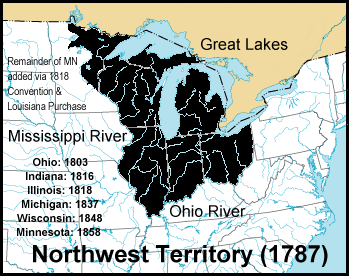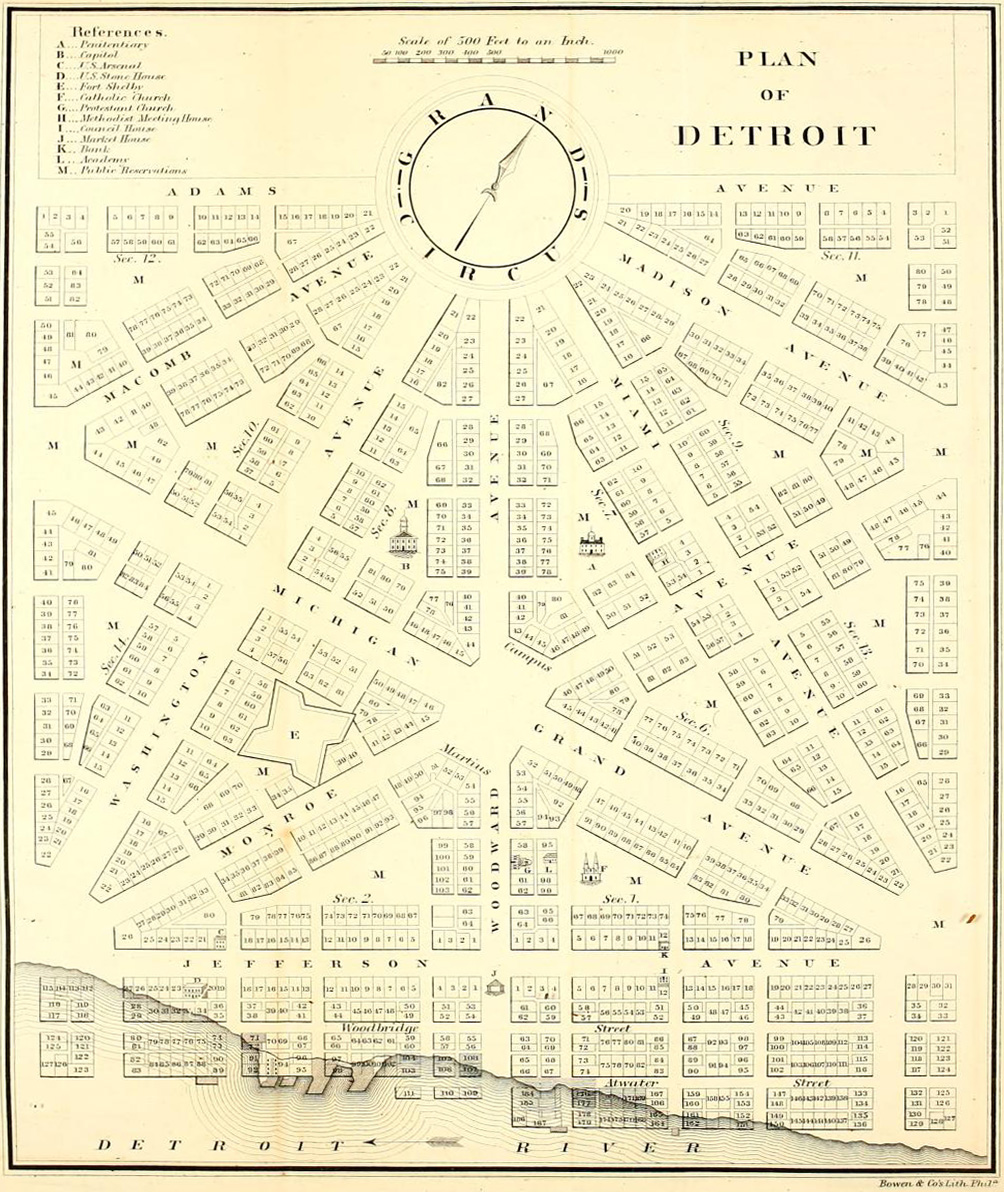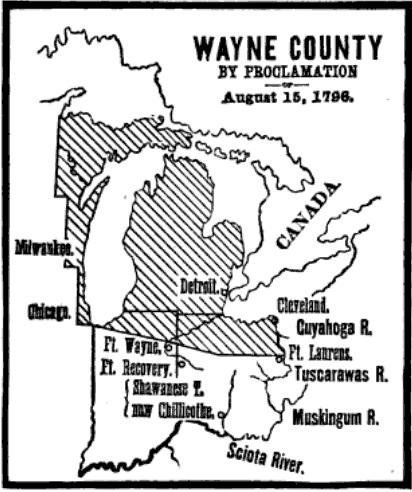|
1818 Michigan Territory General Assembly Referendum
The 1818 Michigan Territory general assembly referendum was held in the Territory of Michigan to determine whether a majority of the territory's Freehold (law), freeholders favored the creation of a general legislative assembly to replace the system of governors and judges in effect at the time, as provided for by the Northwest Ordinance. The election was called by Territorial Governor Lewis Cass, and results showed a majority opposed changing the system of government. Background The Northwest Ordinance outlined three stages of government for the Northwest Territory. The first stage consisted of a governor, a secretary, and three judges; the governor and judges together formed the legislative branch of government. The second stage called for a general assembly comprising the territorial governor, an elected house of representatives, and a five-person legislative council; this stage was to be instituted when the territory contained 5000 "free male inhabitants of full age" an ... [...More Info...] [...Related Items...] OR: [Wikipedia] [Google] [Baidu] |
Michigan Territory
The Territory of Michigan was an organized incorporated territory of the United States that existed from June 30, 1805, until January 26, 1837, when the final extent of the territory was admitted to the Union as the State of Michigan. Detroit was the territorial capital. History and government The earliest European explorers of Michigan saw it mostly as a place to control the fur trade. Small military forces, Jesuit missions to Native American tribes, and isolated settlements of trappers and traders accounted for most of the inhabitants of what would become Michigan. Early government in Michigan After the arrival of Europeans, the area that became the Michigan Territory was first under French and then British control. The first Jesuit mission, in 1668 at Sault Saint Marie, led to the establishment of further outposts at St. Ignace (where a mission began work in 1671) and Detroit, first occupied in 1701 by the garrison of the former Fort de Buade under the leadership of ... [...More Info...] [...Related Items...] OR: [Wikipedia] [Google] [Baidu] |
Freehold (law)
In common law jurisdictions such as England and Wales, Australia, Canada, and Ireland, a freehold is the common mode of ownership of real property, or land, and all immovable structures attached to such land. It is in contrast to a leasehold, in which the property reverts to the owner of the land after the lease period expires or otherwise lawfully terminates. For an estate to be a freehold, it must possess two qualities: immobility (property must be land or some interest issuing out of or annexed to land) and ownership of it must be forever ("of an indeterminate duration"). If the time of ownership can be fixed and determined, it cannot be a freehold. It is "An estate in land held in fee simple, fee tail or for term of life." The default position subset is the perpetual freehold, which is "an estate given to a grantee for life, and then successively to the grantee's heirs for life." England and Wales Diversity of freeholds before 1925 In England and Wales, before the Law of P ... [...More Info...] [...Related Items...] OR: [Wikipedia] [Google] [Baidu] |
Northwest Ordinance
The Northwest Ordinance (formally An Ordinance for the Government of the Territory of the United States, North-West of the River Ohio and also known as the Ordinance of 1787), enacted July 13, 1787, was an organic act of the Congress of the Confederation of the United States. It created the Northwest Territory, the new nation's first organized incorporated territory, from lands beyond the Appalachian Mountains, between British North America and the Great Lakes to the north and the Ohio River to the south. The upper Mississippi River formed the territory's western boundary. Pennsylvania was the eastern boundary. In the 1783 Treaty of Paris, which formally ended the American Revolutionary War, Great Britain yielded the region to the United States. However, the Confederation Congress faced numerous problems gaining control of the land such as the unsanctioned movement of American settlers into the Ohio Valley; violent confrontations with the region's indigenous peoples; the ... [...More Info...] [...Related Items...] OR: [Wikipedia] [Google] [Baidu] |
Lewis Cass
Lewis Cass (October 9, 1782June 17, 1866) was an American military officer, politician, and statesman. He represented Michigan in the United States Senate and served in the Cabinets of two U.S. Presidents, Andrew Jackson and James Buchanan. He was also the 1848 Democratic presidential nominee. A slaveowner himself, he was a leading spokesman for the Doctrine of Popular Sovereignty, which held that the people in each territory should decide whether to permit slavery. Born in Exeter, New Hampshire, he attended Phillips Exeter Academy before establishing a legal practice in Zanesville, Ohio. After serving in the Ohio House of Representatives, he was appointed as a U.S. Marshal. Cass also joined the Freemasons and would eventually co-found the Grand Lodge of Michigan. He fought at the Battle of the Thames in the War of 1812 and was appointed to govern Michigan Territory in 1813. He negotiated treaties with Native Americans to open land for American settlement and led a survey ... [...More Info...] [...Related Items...] OR: [Wikipedia] [Google] [Baidu] |
Northwest Territory
The Northwest Territory, also known as the Old Northwest and formally known as the Territory Northwest of the River Ohio, was formed from unorganized western territory of the United States after the American Revolutionary War. Established in 1787 by the Congress of the Confederation through the Northwest Ordinance, it was the nation's first post-colonial organized incorporated territory. At the time of its creation, the territory included all the land west of Pennsylvania, northwest of the Ohio River and east of the Mississippi River below the Great Lakes, and what later became known as the Boundary Waters. The region was ceded to the United States in the Treaty of Paris of 1783. Throughout the Revolutionary War, the region was part of the British Province of Quebec. It spanned all or large parts of six eventual U.S. states ( Ohio, Indiana, Illinois, Michigan, Wisconsin, and the northeastern part of Minnesota). Reduced to present-day Ohio, eastern Michigan and a sliver ... [...More Info...] [...Related Items...] OR: [Wikipedia] [Google] [Baidu] |
Territory Of Indiana
The Indiana Territory, officially the Territory of Indiana, was created by a congressional act that President John Adams signed into law on May 7, 1800, to form an organized incorporated territory of the United States that existed from July 4, 1800, to December 11, 1816, when the remaining southeastern portion of the territory was admitted to the Union as the state of Indiana. The territory originally contained approximately of land, but its size was decreased when it was subdivided to create the Michigan Territory (1805) and the Illinois Territory (1809). The Indiana Territory was the first new territory created from lands of the Northwest Territory, which had been organized under the terms of the Northwest Ordinance of 1787. The territorial capital was the settlement around the old French fort of Vincennes on the Wabash River, until transferred to Corydon near the Ohio River in 1813. William Henry Harrison, the territory's first governor, oversaw treaty negotiations with t ... [...More Info...] [...Related Items...] OR: [Wikipedia] [Google] [Baidu] |
Augustus Woodward
Augustus Brevoort Woodward (born Elias Brevoort Woodward; November 1774 – June 12, 1827) was the first Chief Justice of the Michigan Territory. In that position, he played a prominent role in the reconstruction of Detroit following a devastating fire in 1805. He promoted an urban design based on radial avenues, as in Washington, DC and Paris. He is also known as one of the founders of the University of Michigan, established by the legislature in 1817. Early life He was born Elias Brevoort Woodward in 1774 in New York, the son of John and Ann Silvester Woodward. His mother was of Flemish ancestry, and his father was of English descent. John Woodward was a merchant and importer, as well as a member of the Continental Army. The family lived in Manhattan on the corner of Pine and Pearl Streets. Woodward graduated from Columbia College. After working in Philadelphia as a clerk in the U.S. Treasury Department, he later read the law and practiced as an attorney in Washing ... [...More Info...] [...Related Items...] OR: [Wikipedia] [Google] [Baidu] |
John Griffin (judge)
John Griffin (born 1774 or 1779 – death unknown) was an American judge. He was one of the original judges of the Supreme Court of Michigan Territory. Griffin was born in either Scotland or Virginia Virginia, officially the Commonwealth of Virginia, is a state in the Mid-Atlantic and Southeastern regions of the United States, between the East Coast of the United States, Atlantic Coast and the Appalachian Mountains. The geography an ....Chardavoyne says Griffin was born in Scotland. Burton and Ross say he was a native of Virginia, while the Michigan Supreme Court Historical Society states that Griffin was born in Virginia. His father was Cyrus Griffin, the last president of the Continental Congress, and his mother was the daughter of a Scottish baron. He graduated from the College of William and Mary and studied law, and was appointed a judge in the Indiana Territory in 1800 by President John Adams. He did not like the climate, and in 1806 his father convinced Presiden ... [...More Info...] [...Related Items...] OR: [Wikipedia] [Google] [Baidu] |
Mackinac County, Michigan
Mackinac County ( ) is a County (United States), county in the Upper Peninsula of the U.S. state of Michigan. As of the 2020 United States Census, 2020 Census, the population was 10,834. The county seat is St. Ignace, Michigan, St. Ignace. Formerly known as Michilimackinac County, in 1818 it was one of the first counties of the Michigan Territory, as it had long been a center of French and British colonial fur trading, a Catholic church and Protestant mission, and associated settlement. The county's name is believed to be shortened from "''Michilimackinac''", which referred to the Straits of Mackinac area as well as the French settlement at the tip of the lower peninsula. History Michilimackinac County was created on October 26, 1818, by proclamation of territorial governor Lewis Cass. The county originally encompassed the Lower Peninsula of Michigan north of Macomb County, Michigan, Macomb County and almost the entire present Upper Peninsula. As later counties were settled and ... [...More Info...] [...Related Items...] OR: [Wikipedia] [Google] [Baidu] |
Wayne County, Michigan
Wayne County is the most populous county in the U.S. state of Michigan. As of 2020, the United States Census placed its population at 1,793,561, making it the 19th-most populous county in the United States. The county seat is Detroit. The county was founded in 1796 and organized in 1815. Wayne County is included in the Detroit- Warren-Dearborn, MI Metropolitan Statistical Area. It is one of several U.S. counties named after Revolutionary War-era general Anthony Wayne. History Wayne County was the sixth county in the Northwest Territory, formed August 15, 1796 from portions of territorial Hamilton County, territorial Knox County and unorganized territory. It was named for the U.S. general "Mad Anthony" Wayne. It originally encompassed the entire area of the Lower Peninsula of Michigan, most of the Upper Peninsula, as well as smaller sections that are now part of northern Ohio, Indiana, Illinois and Wisconsin. By proclamation of the Territorial Secretary and Acting Go ... [...More Info...] [...Related Items...] OR: [Wikipedia] [Google] [Baidu] |







